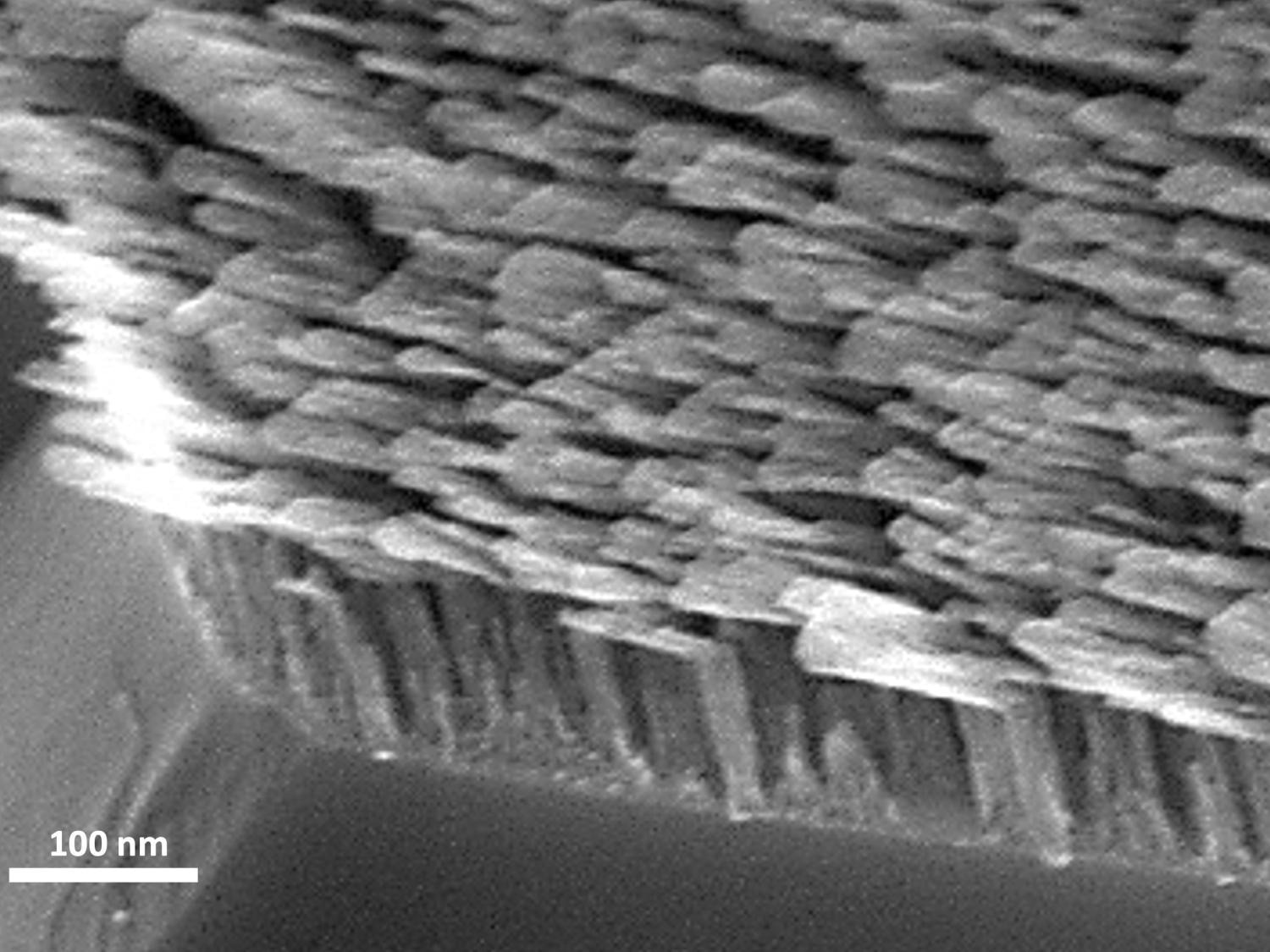An international group of researchers from The Pennsylvania State University and the University of Nebraska-Lincoln (UNL) developed a new optical device that controls the direction of light waves which helps scientists to determine the chirality of molecules and direct them. It has a wide range of applications in the field of biomedicine. This research was published in the journal Nature.
 Researchers fabricated an optical element that uses a forest of tiny, antenna-like nanorods, seen here, that together create a metamaterial able to control the spin of light. The metamaterial nanorods appear to be shaped like the letter “L” when seen at the nanoscale. Image Credit: Christos Argyopoulos
Researchers fabricated an optical element that uses a forest of tiny, antenna-like nanorods, seen here, that together create a metamaterial able to control the spin of light. The metamaterial nanorods appear to be shaped like the letter “L” when seen at the nanoscale. Image Credit: Christos Argyopoulos
When polarized light waves contact molecules, they spin either clockwise or counterclockwise, with one orientation exhibiting distinct behavior. This directionality, known as chirality or handedness, may help distinguish and classify particular molecules for use in biomedical applications, but researchers have had little control over the waves' direction up until now.
Determining a molecule's chirality can provide important insights into how it will interact with other systems, such as whether a particular medication can treat damaged or diseased tissue without endangering healthy cells.
Christos Argyropoulos, Co-Corresponding Author of the paper and an Associate Professor of Electrical Engineering at Penn State, defined chirality as mirror images, such as the left and right hands joining in a handshake. Chirality in physics affects the direction in which light waves spin, among other things.
Argyropoulos and his colleagues created a metamaterial, or material designed to have particular qualities not usually found in nature, by using a forest of small, antenna-like nanorods to construct an optical element that resembles a glass slide and is capable of controlling the spin of light. At the nanoscale, the metamaterial nanorods have a form like the letter “L.”
When the light-matter interaction is mediated by the metamaterials, you can image a molecule and identify its chirality by inspecting how chiral light interacts with it.
Christos Argyropoulos, Study Co-Corresponding Author and Associate Professor, Department of Electrical Engineering, The Pennsylvania State University
UNL researchers made the optical element of silicon using glancing angle deposition, a recently developed production technique.
Silicon does not substantially dissipate the incident light that was problematic with metal, which we used in previous attempts to create the element, and silicon allowed us to adjust the shape and length of the nanopillars on the platform, which in turn allows us to change how we control the light.
Ufuk Kilic, Research Professor and Study Co-Corresponding Author, University of Nebraska-Lincoln
Determining a molecule's chirality can broadly impact biomedicine, especially when it comes to pharmaceutical medications, which can occasionally have left- or right-handed chirality, according to Argyropoulos.
A molecule with a left-handed structure may be hazardous to healthy cells, even while a molecule with a right-handed shape may be useful in treating disease.
Argyropoulos brought up the well-known instance of thalidomide, a medication with a chiral structure that was given as the treatment for morning sickness to female patients from 1957 to 1962.
The right-handed molecule was effective in alleviating nausea but proved highly toxic to developing fetuses, leading to birth defects in thousands of babies worldwide. According to Argyropoulos, the optical element can swiftly picture the chemical structure of drugs, helping scientists comprehend the subtleties of drug action.
The optical element can also be used to produce left- or right-handed electromagnetic waves, which are essential for the creation and upkeep of quantum and classical communications networks, such as encrypted Wi-Fi and cell phone service.
Previously, for optical communication systems, you needed big, bulky devices that only operated at one frequency, this new optical element is lightweight and easily tunable to multiple frequencies.
Christos Argyropoulos, Study Co-Corresponding Author and Associate Professor, Department of Electrical Engineering, The Pennsylvania State University
Matthew Hilfiker, Shawn Wimer, Alexander Ruder, Eva Schubert, and Mathias Schubert, all from UNL, are co-authors of the research.
The US National Science Foundation, the Air Force Office of Scientific Research, the University of Nebraska Foundation, and the J.A. Woollam Foundation funded the research.
Journal Reference:
Kilic, U., et al. (2024) Controlling the broadband enhanced light chirality with L-shaped dielectric metamaterials. Nature Communications. doi.org/10.1038/s41467-024-48051-4.